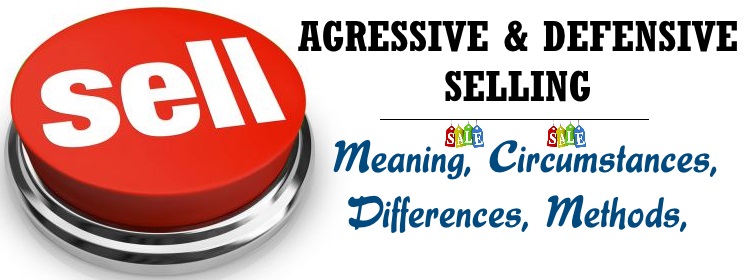Aggressive Selling | Meaning | Aggressive vs Defensive | Circumstance | Methods
Table of Contents
Meaning of Aggressive Selling

Aggressive selling (also known as offensive selling) refers to the various sales efforts made aggressively or vigorously by a manufacturer to obtain increased volume of sales for his product. In other words, it refers to the various efforts made by a manufacturer to effect additional sales over and above the usual sales for his product.
The volume of sales can be increased in two ways, viz.,
- by capturing the established market of the competitors, i.e., by taking away the customers from the rival firms and
- by expanding the market, i.e., by tapping new customers.
The sales efforts made to obtain increased volume of sales are called aggressive selling or offensive selling as the manufacturer is required to be aggressive in the sales efforts made to capture the established market of the competitors or in tapping new customers.
Defensive Selling
Defensive selling refers to all those sales efforts made by a manufacture to protect his already established market against his competitors. In other words, Defensive selling refers to all those sales efforts made by a manufacturer to retain existing customers, i.e., to maintain his current sales. If these efforts are not made, he will lose his established market to his competitors.
Aggressive or offensive selling is different from defensive selling. The main differences between the two are given below:
Aggressive Selling vs Defensive Selling
1. Aggressive or offensive selling includes those sales efforts made by a manufacturer with the specific purpose of increasing the volume of sales of his product. Defensive selling covers those sales efforts made by a manufacturers to retain the existing market, i e., to maintain his current sales..
2. Through aggressive selling, a manufacturer may attract the customers from his rivals. If a manufacturer does not undertake defensive selling, he is likely to lose his existing customers to his rivals.
3. Aggressive selling resulting in the expansion of the market (i.e., tapping of the new customers) is beneficial not only to the manufacturer, but also to other manufacturers in the same line of business. Defensive selling is useful only to the manufacturer undertaking defensive selling.
Circumstances suitable for Aggressive Selling
Aggressive selling is undertaken by a manufacturer, under the following circumstances:
1. When his share of the market is small.
2. When the market for his product is expanding.
3. When some improvements have been made in the product.
4. When his product is superior when compared to the product of his competitors.
5. When he has introduced a new product.
6. When he has not used full production capacity and he wants to utilize the plant to its full capacity.
7. When he wants to exhaust the piled-up stocks.
8. When he has to create demand for his product by educating the consumers regarding the uses of his product.
Methods of Aggressive Selling
The various aggressive sales efforts made may be grouped under two classes.viz.,
- Trade or dealer promotional methods
- Consumer promotional methods.
Trade Promotional Methods
Trade promotional methods refer to the special incentives offer by a manufacturer to dealers or traders so as to induce them to buy more of his products. They include the following:
1. Special discount, higher discount or price deal
Under this method, the manufacturer grants special discount or high rate of discount (i.e., discount over and above the regular discount) to dealers who purchase goods from him in large quantities.
For instance, if the regular discount is 5%, he may offer a discount of 8% for purchases over a certain amount. Alternatively, he may give different rates of discount for different quantities of purchases. For instance, he may give 5% discount for purchases of Rs.10,000, 10% discount for purchases of Rs. 20,000, 15% discount for purchases of Rs. 30,000 and so on.
2. Cash Discount
In order to discourage credit sales, traders are encouraged to purchase goods by paying cash, because of which additional discount (ranging from 1 to 5%) is offered to them. This is known as cash discount.
3. Extra product or merchandise deal
Under this method, an extra or additional quantity of the product is given by the manufacturer to the dealers for purchases of every fixed quantity of the product. For instance, a soap manufacturer may offer to the dealers a case of 25 cakes of soap for every 20 cakes of soap at the same price as that of 20 cakes of soap.
4. Gifts or premium offers
Under this method, a manufacturer offers to the dealers attractive and useful articles, such as wall clock, T.V., show cases, cell phones, etc., as gifts or prizes against the orders of specified amount.
5. Dealer coupons
Under this method, the manufacturer offers to the dealers gift coupons for bulk purchases. The dealers can exchange the gift coupons for gift articles listed in the catalogue.
6. Dealer contests
Under this method, the manufacturer organizes a sales contest or competition among the dealers and gives prizes to dealers on the basis of their sales performance during a given period.
